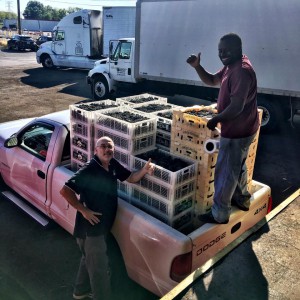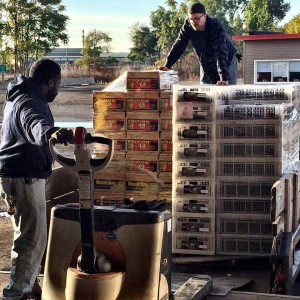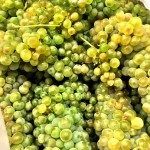Musto Crush Crew Pre-Harvest Traditions
Ever wonder how we prep for harvest?
Frank Musto: “I always pick up two new pairs of work shoes in August, make sure I break them in before season. I usually burn through two pairs each season….Food of choice is McDonalds, nothing takes the pressure of a hard day like a Big Mac, large fries, and a diet coke…After Labor day, I kiss my wife good bye, pet the dog behind the ears, and tell them ill see them in late October.”
Christina Musto: “I’m usually pestering all of the growers for photos of the vineyards. Then I get my house into “harvest mode” stocking up on beer, cider, frozen meals, and chocolate. Finally, I treat myself to purchasing a special bottle of Schramsberg Brut Rose as an “in case of emergency” bottle.
Patrick Milio: “I bid farewell to friends and family, stock up on Beer, Bourbon, and Bubbles to enjoy after long days at the shop, and pre-emptively apologize to my digestive system for the terrible nightly takeout meals that are to come.”
Colin Mulryan: “I go through all of my old clothes to wear for the season, because it all gets thrown out at the end. And stock the fridge with beer.”
Ken Milio: Our Harvest tradition starts the week before as its time to clean and sanitize last year’s Crusher / Destemmer, Fermenting tubs, Must Plungers and other small items. You can tell how much wine was consumed last year by the cleanliness of the equipment this year. On crush day, our tradition is that all involved toast the new season with a shot of “ Honey Grappa “. After the crush, we again clean and sanitize the equipment then the drinking and eating begins.
Frank Renaldi: “The first thing I do to prepare for harvest is to think of another way to trick my wife into thinking I am not making a lot of wine. Last year I told her she miscounted the number of cases of grapes on the truck. The year before I told her each case of grapes weighed 10 pounds.
Then I get down to business and take inventory of my supplies and order what I need by July. I also decide on the grapes I want to work with and reserve my order. Then I check all my equipment to make sure it is ready for the big day. I talk to all my wine making friends and we get excited like little kids getting ready for their first day of school – well it does happen at the same time of the year. I think this year I will tell my wife, I had to buy more because the grapes were smaller this year.”
Barry St. Pierre: “First thing is to make and freeze a big pot of chili…for friends who stop by to help or for ourselves when we are too tired to make anything else. Full tanks have to be bottled or moved to free up space for new grapes and wine. Of course we pre-clean all of our equipment, especially our feet…need to be sure to remove all toe jam. By now all supplies are ordered, especially grapes from Musto…I seem to always get yelled at for not ordering early enough. Then sit back, open a bottle of wine, and wait for the grapes to ripen and arrive.”
Robert Herold: “As the harvest/crush/press day approaches, I start fortifying myself with wine several days in advance. For the actual activity day, nothing works as well as beer to make the task go smoothly. To quote a very good winemaker friend of mine, ‘it takes a lot of good beer to make a good wine’.”
Notes from our Winemaker Frank Renaldi about the Chilean Sauvignon Blanc: After the Press
Notes from our Winemaker Frank Renaldi about the Chilean Sauvignon Blanc:
After the Press
“Adjusted Brix to 21.5 (11.8% alcohol). Adjusted with Tartaric Acid to get pH = 3.24 and TA = .60. Will have to acidify after fermentation. Could have adjusted further, but ta would still be low (desired .7 – .9). Used Vin13 yeast – Very slow start. Took over 24 hours to get started. Still at 58 degree with a slow cool fermentation. No big nose yet. Looking forward to reporting more on the results once fermentation has completed.”
Don’t forget to sign up for the Spring Bootcamp with winemaker Frank Renadli! Learn how to make great wine at home in just 5 weeks!
The Winemaker’s Think Tank: Vol 12- Common Winemaking Faults and Flaws
What’s the Winemaker’s Think Tank?
Every Thursday we will post about a few frequently asked questions that our winemaker has answered. If you have a winemaking question you would like to have answered, please email us at support@juicegrape.com and we will try to get into next week’s post. Cheers! 🙂
In this week’s Winemaker’s Think Tank we outline the difference between flaws, faults, and how to identify them.
- Flaws
- Flaws are a mistake made in the winemaking process that leads to a property in the wine that is not characteristic of the varietal
- Stylistic Choice vs. Flaw
- Imbalance Flaw
- Acid vs Sugar, Oak Levels, Alcohol Level
- Visual Flaws
- Haze, Sediment, Effervescence, TA Crystals, Floaters, Lack of Color Saturation
- Aroma/Bouquet Flaws
- Lack of Aroma, Non-varietal aroma, Over-oaking
- Faults
- Faults are often a microbial or chemical reaction within the wine in some part of its life that significantly alters a wine, eventually leading to the point of spoilage.
- Oxidation Faults
- Acetaldehyde – oxidation of Ethyl Alcohol smells like sherry, or old apples, browning
- Causes: headspace, low sulfites, poor corks, bacterial contamination
- Acetic Acid – Vinegar
- Causes: Acetaldehyde, Acetobacter bacteria react with ethanol, Fruit Flie
- Ethyl Acetate – Nail Polish Smell
- Oxidation of Acetaldehyde and Acetic Acid
- Causes: headspace and bacterial contamination
- Acetaldehyde – oxidation of Ethyl Alcohol smells like sherry, or old apples, browning
- Sulfur Faults
- Hydrogen Sulfide – Rotten Eggs Smell
Causes: lack of yeast nutrients, yeast stress, sulfur sprays, yeast bi-product, high temps - Sulfur Dioxide – Burnt Match Smell
Causes: over sulfating, wild yeast - Complex Sulfur Faults- Mercaptans, DMS, DES, DMDS, DEDS
Causes: Hydrogen Sulfide reacting with Ethyl Alcohol
- Hydrogen Sulfide – Rotten Eggs Smell
- Microbial Faults
- Brettanomyces – Barnyard, Horse Saddle, Antiseptic Ointment, Band-Aids, Bacon, Clove
- Causes: spoilage yeast cells that are incredibly dangerous and difficult to eliminate. Most often found in contaminated barrels, winery cleanliness, resistant to acid and SO2
- Geranium Taint – Fresh cut geranium leaves
- Causes: Reaction of potassium sorbate with Lactic Acid Bacteria in the presence of Ethyl Alcohol
- Refermentation – Fizzy wine, popped corks
- Causes: Yeast or microbial fermentation of residual sugar
- Brettanomyces – Barnyard, Horse Saddle, Antiseptic Ointment, Band-Aids, Bacon, Clove
- Other Faults
- Cork Taint – Wet basement, wet old newspaper, mildew
- Causes: strain of trichloanisole on cork (cork taint); mold that contacts chlorine and wood
- Heat Damage – Cooked fruit smell, brick red color, similar to oxidation
- Causes: leaving wine in a hot car, in the sun, etc.
- Cork Taint – Wet basement, wet old newspaper, mildew
We hope this information helps with your winemaking. If you have any follow up questions or winemaking questions in general, please email us at support@juicegrape.com.














Recent Comments